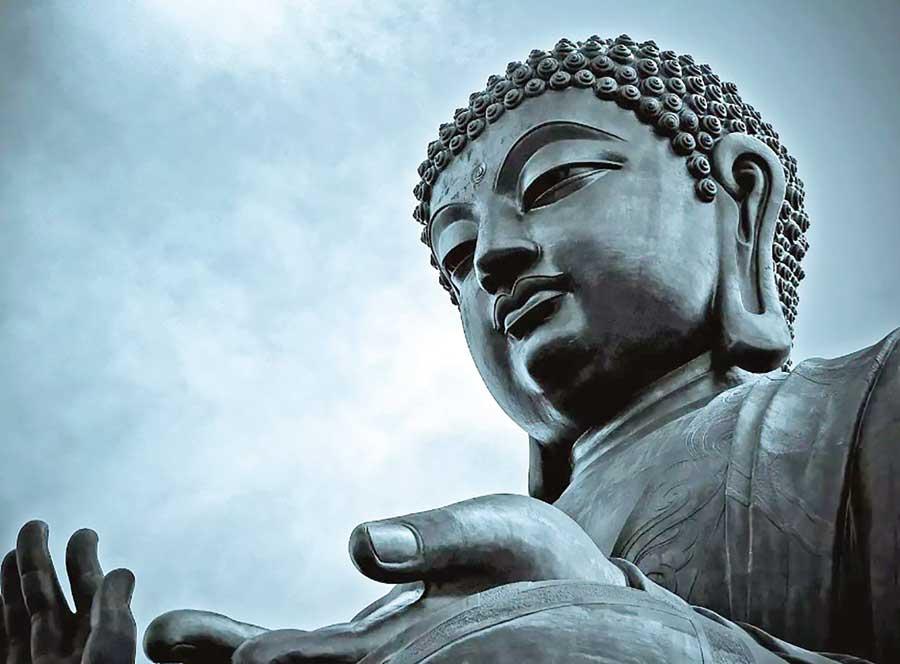05 May 2023 - {{hitsCtrl.values.hits}}

This explains that one who knows the Dhamma is able to see the Buddha. The Mahahatthipodupama Sutta in the Majjhima Nikaya says that the person who understands dependent origination can see the Dhamma and one who can see the Dhamma understands dependent origination
Although the Buddha lived over two thousand six hundred years ago, it is still possible to see him through his Teachings. We can also gain an understanding of him by reading numerous books that have been published over the years. The Buddhist world has sculptured statues of the Buddha which portray his unique compassionate and dynamic personality.
books that have been published over the years. The Buddhist world has sculptured statues of the Buddha which portray his unique compassionate and dynamic personality.
It is in these ways we try to imagine and understand what type of person he was. At the same time, the Buddha himself pointed out a way to see him by following his path. To help us see him, we find passages in the Suttas which explain his character and qualities, his way of life, and his philosophy.
Once there was a faithful disciple named Vakkali, who always wanted to be in the presence of the Buddha. When Vakkali fell ill he requested a visit from the Buddha. He was asked by the Buddha what was troubling him, and Vakkali replied that what bothered him most was that he could not see the Buddha every day since he was ill.
Then the Buddha said:
“Vakkali, what good is there in seeing this decaying body of mine? One who knows the Dhamma sees me. One who sees me sees the Dhamma. Vakkali, one who knows the Dhamma sees me.”
This explains that one who knows the Dhamma is able to see the Buddha. The Mahahatthipodupama Sutta in the Majjhima Nikaya says that the person who understands dependent origination can see the Dhamma and one who can see the Dhamma understands dependent origination. The following verse refers to dependent origination:
“When this is, -- that is.
This arising, -- that arises.
When this is not, -- that is not.
This ceasing, -- that ceases.”
Therefore, by understanding and experiencing dependent origination we can realize the teaching of the Buddha.
The Suttas of the Sutta Pitaka contain descriptive narratives of the Buddha by some of his disciples. They tell of the manner in which he solved problems, the way he addressed people, how he handled situations for peaceful results, his wisdom and foresight, and so on. Reading these Suttas can provide one with an experience of the Buddha.
The Buddha is often referred to in Pali Suttas as having nine qualities. Buddhists recite, “Itipi so bhagava araham samma sambuddho ... “ Through this verse the Buddha’s nine qualities are enumerated: “Such, indeed is the Blessed One,
Perfected, fully awakened,
Endowed with knowledge and virtue,
Having walked the right path,
The knower of worlds;
Incomparable guide of willing persons,
Teacher of gods and humans,
Awakened and blessed.”
During the Buddha’s lifetime, he was respected by other religious leaders and considered their spiritual friend. He was popularly known as “Bhagava” which means blessed one, but the Buddha referred to himself as “Tathagata,” a person who followed the path and attained the goal of Nibbana.
The Buddha’s associates expressed their opinions about him. Once, Venerable Assaji met Upatissa, a young man who later became the monk named Sariputta. Upatissa asked him to describe his teacher.
Venerable Assaji replied:
“When something arises it is due to a cause, and those reasons were explained by my teacher. He also explained how the arising ceases as well. I am following that type of teacher.”
It is because of this description that Upatissa became a monk and was eventually known as the Buddha’s Chief Disciple.
Venerable Ananda, the Buddha’s chief attendant says this of him to
Gopaka Moggallana:
“The Buddha is the one who discovered a path to happiness for those who are ignorant of the correct way. He is the person who knew the path; tread the path; experienced the path; and followed the path to the end to gain ultimate peace and happiness.”
A Brahmin named Drona, travelling along the same road after the Buddha, was amazed when he saw some footprints and thought:
“These can never be the footprints of a
human being.”
Drona followed the footprints and found the Buddha seated under a tree very calm and serene. The following conversation took place:
The Brahmin asked the Buddha:
“Are you a god?”
“No Brahmin, I am not a god.”
“Are you a gandhabba (divine musician)?”
“No Brahmin, I am not a gandhabba.”
“Are you a yakkha?”
“No Brahmin, I am not a yakkha.”
“Are you a human being?”
“No Brahmin, I am not a human being either.”
Then the Brahmin said:
“When I ask you whether you are a god, you say, ‘No I am not a god.’ When I ask you whether you are a gandhabba, a yakkha or a human being, you say ‘No’. If that is so, who are you?”
The Buddha replied:
“O Brahmin, if I am a god, I must have godly sense-desires. But I have eradicated sense-desires fully. Therefore, I am not a god. If I am a gandhabba, I must have gandhabba sense-desires. But I have eradicated sense-desires fully. Therefore, I am not a gandhabba. If I am a yakkha then I must have the sense-desires that a yakkha would have. But I have eradicated all sense-desires fully. Therefore, I am not a yakkha either. Then if I am an ordinary human being, I must have the sense-desires of ordinary human beings. But I have totally eradicated sense-desires. Therefore, I am not a human being like other
human beings.”
The Buddha continued:
“O Brahmin, a blue lotus, red lotus or white lotus is born in the water. It grows in the water. But it remains uncontaminated and untouched by water. I, too, am like that. I was born among human beings in this world. I grew up among human beings in this world. But I have risen above the world of ordinary human beings. I am not attached to the world. Therefore, O Brahmin, I am a superior human being who has destroyed all the weaknesses of ordinary human beings (uttaramanusso). In short, I am a Buddha. The best way to describe me is ‘Buddha.’ O Brahmin, please call me ‘Buddha.’”
This is one of the ways the Buddha described himself. Many others can be found in the Suttas.
“One who has gone for refuge to the Buddha,
to the Buddha’s Teaching and to the Sangha;
Penetrating the transcendental wisdom of the Four Noble Truths:
“There is suffering.
There is a cause for suffering.
Suffering can cease.
The Noble Eightfold Path leads to the cessation of suffering.”-Dhammapada
190-191
10 Jan 2025 6 minute ago
10 Jan 2025 21 minute ago
10 Jan 2025 2 hours ago
10 Jan 2025 2 hours ago
10 Jan 2025 3 hours ago